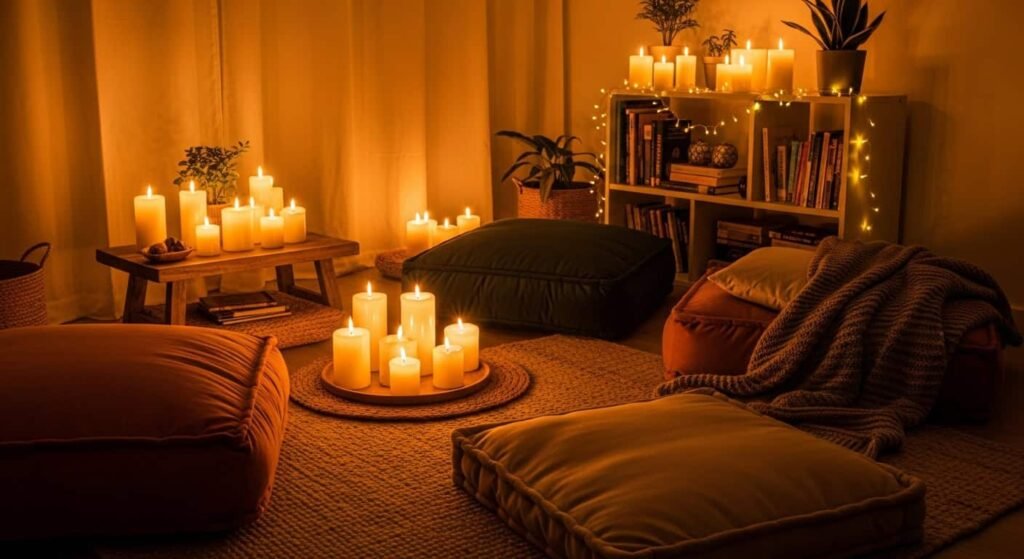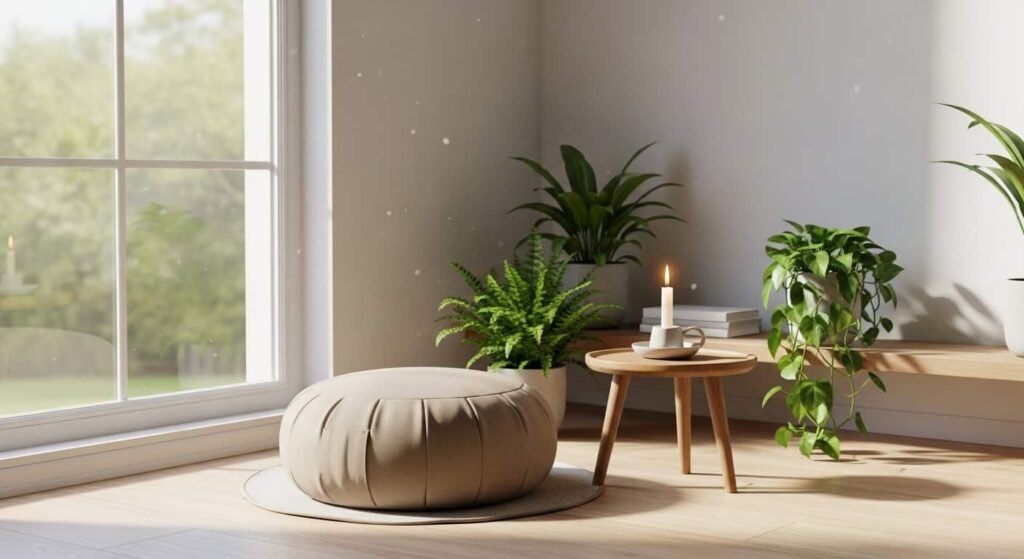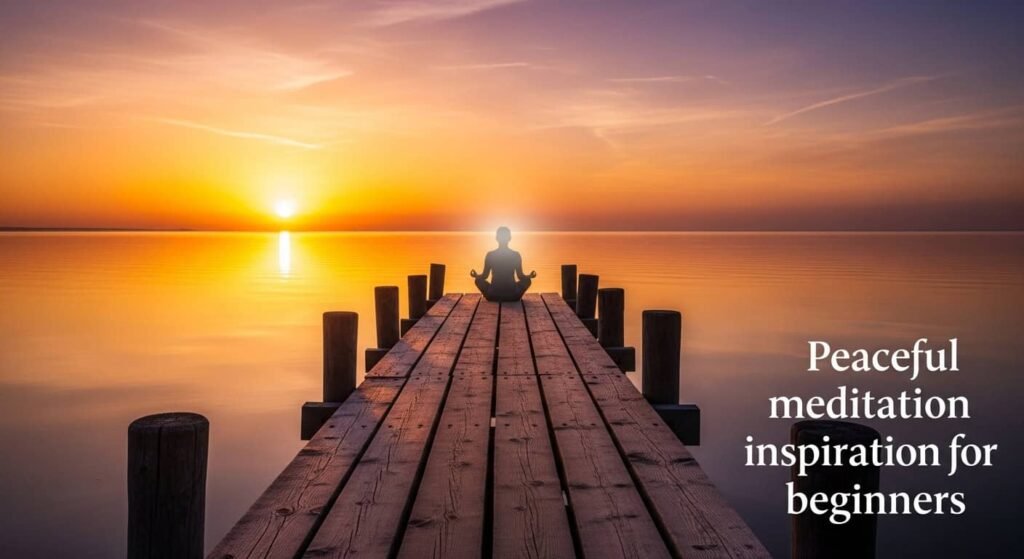Ever feel like your brain’s got too many tabs open? Notifications popping up, thoughts bouncing around, and you can’t find the “mute” button? Yeah, same. That’s where meditation swoops in like a quiet superhero — no cape, just calm. And no, you don’t need to sit on a mountain in silence for 12 hours to get started. You just need a few minutes, a little curiosity, and maybe a comfy chair.
Let’s talk about how you can start meditating today, even if you’ve got a brain that acts like it’s running on 47 cups of coffee. 🙂
Why Meditation Matters (Especially If You Think You Don’t Have Time)
You’ve probably heard people say, “Meditation changed my life.” Sounds dramatic, right? But here’s the deal — it actually can. Meditation helps you focus, relax, and handle stress like a champ. Think of it as a mental gym — but instead of lifting weights, you’re lifting awareness.
And before you roll your eyes and say, “I can’t stop my thoughts,” let me tell you something — no one can. Meditation isn’t about emptying your mind; it’s about not getting dragged by every random thought that passes through.
Here’s what meditation helps with:
- Reduces stress and anxiety
- Improves focus and concentration
- Boosts emotional health
- Helps you sleep better
- Makes you a little kinder (to others and yourself)
Honestly, who doesn’t need more of that?
Step 1: Find Your “Why” (It’s More Important Than You Think)
Before you jump into meditation, ask yourself: Why do I want to do this?
Is it to relax? To manage anxiety? To be more mindful in your daily chaos? Your reason becomes your anchor when your brain starts protesting halfway through (and it will).
For example, I started meditating because my stress levels could probably power a small city. At first, I didn’t feel much. But after a week, I noticed I wasn’t snapping at every inconvenience (a miracle, really). That’s when I got hooked.
So, write down your reason somewhere. You’ll thank yourself later when you’re tempted to skip it.
Step 2: Choose a Type of Meditation That Fits You
Here’s a secret: there’s no one-size-fits-all kind of meditation. Some people love silent meditation, while others prefer guided audio sessions. You’ve got options, and that’s good news.
1. Mindfulness Meditation
This one’s all about paying attention to the present moment — your breath, sounds, sensations. When your mind wanders (and it will), you gently bring it back. Think of it as brain push-ups.
2. Guided Meditation
Perfect for beginners. You follow along with a calm voice (usually from an app like Headspace or Calm). It’s like having a meditation GPS — less chance of getting lost in thought.
3. Loving-Kindness Meditation
Want to feel more compassionate? This one helps you cultivate feelings of love, kindness, and forgiveness. Sounds cheesy, but it works.
4. Body Scan Meditation
You mentally “scan” your body from head to toe, noticing tension and relaxing each part. Great for releasing stress after a long day.
5. Walking Meditation
Yes, walking counts! You focus on each step, your breathing, and the rhythm of movement. It’s meditation on the go.
Try a few and see what clicks. There’s no “wrong” way — only what feels right for you.
Step 3: Pick a Time (and Stick to It)
Meditation works best when it’s part of your daily routine — like brushing your teeth or checking your phone (but healthier).
Morning meditation can set a calm tone for the day, while evening meditation helps you unwind. Personally, I do it in the morning — because if I wait till night, my brain’s already in Netflix mode.
Pro tip: Start small — like 5 minutes a day. Once you get comfy, bump it up to 10 or 15. Consistency beats intensity every time.
Set a reminder, use an app, or stick a Post-it on your mirror that says “Breathe, human.” Whatever works. 🙂
Step 4: Create a Calm Spot
You don’t need a fancy meditation room with incense and Buddha statues (unless you’re into that). Just find a quiet, comfortable space where you won’t be disturbed.
Here’s what helps:
- A comfortable chair or cushion
- Soft lighting (or natural light)
- Phone on silent (yep, that includes notifications)
- Maybe a candle or essential oil diffuser if that’s your vibe
You’re basically creating a little “peace bubble” for your brain.
More Read: What Is Spiritual Awakening?
Step 5: Focus on Your Breath (The OG Technique)
The simplest and most powerful way to meditate? Breathing. It’s literally always there, and it keeps you grounded.
Here’s how to do it:
- Sit comfortably and close your eyes.
- Take a deep breath in through your nose, and slowly exhale through your mouth.
- Notice the sensation — your chest rising, your breath flowing, your body relaxing.
- When your mind wanders (and trust me, it will), gently bring it back to the breath.
That’s it. No secret formula, no mystical chanting required (unless you want to). Just observe, breathe, repeat.
Step 6: Be Kind to Your Monkey Mind
If your thoughts are swinging around like hyperactive monkeys, congratulations — you’re normal.
The goal isn’t to silence them, but to notice them without judgment. Imagine watching clouds float by — you don’t grab them, you just see them pass.
Some days you’ll feel super calm; other days, your brain will throw a mental rave. Either way, you showed up. That’s what counts.
Step 7: Use Tools to Stay Consistent
Let’s be honest — building a habit is hard. Luckily, technology’s got your back.
Here are a few tools that can help:
- Apps: Headspace, Calm, Insight Timer (tons of free guided meditations)
- Timers: Use your phone’s timer with a soothing chime instead of an annoying beep
- Journals: Write down how you feel after each session — it helps track progress
- YouTube Channels: Free guided sessions for every level
If you’re the type who needs accountability (same here), join an online meditation challenge or community. Sharing progress keeps you motivated.
Step 8: Deal with Common Beginner Struggles
Alright, let’s talk about the stuff no one warns you about.
“I can’t stop thinking!”
That’s okay — no one can. The goal is to observe thoughts, not delete them. Meditation is like training a puppy — gentle, patient, and repetitive.
“I don’t have time.”
Sure you do. Everyone has five minutes to scroll Instagram — swap that for meditation. Your future self will thank you.
“It feels weird.”
Of course it does! You’re doing something new. Give it a week or two, and you’ll start craving that quiet time.
“I fell asleep.”
Happens to the best of us. Maybe sit instead of lying down next time. 😉
Step 9: Gradually Extend Your Practice
Once you’re comfortable with 5–10 minutes, slowly increase to 15–20 minutes. You’ll be amazed how your patience, focus, and mood start improving.
If you ever feel bored, switch things up — try guided meditations, nature sounds, or even mantra repetition. Keep it fresh so your mind doesn’t wander off (too much).
Step 10: Bring Meditation Into Everyday Life
The real magic happens when you start carrying that calm energy into daily moments — eating, walking, talking, even waiting in traffic (yes, really).
Here’s how:
- Mindful eating: Actually taste your food instead of inhaling it.
- Mindful walking: Notice the ground under your feet, the breeze, the sounds.
- Mindful breaks: Pause for 30 seconds at work and just breathe.
You’ll start realizing that meditation isn’t just something you do — it’s a way of being.
Step 11: Track Your Progress (Without Obsessing)
Keep a small meditation log — note how long you practiced, how you felt before and after. Over time, you’ll notice patterns: calmer mornings, fewer meltdowns, better focus.
Don’t chase perfection. Some days you’ll feel zen; others, not so much. Progress in meditation is often subtle — but it’s there, trust me.
Step 12: Remember — It’s About Progress, Not Perfection
Meditation isn’t a competition. There are no trophies for “Most Peaceful Human.”
So if you skip a day, don’t beat yourself up. Just start again tomorrow. Every time you return, you’re building resilience — and that’s the real win.
Consistency > perfection. Always.
Final Thoughts: Your Calm Is Waiting
So, there you have it — meditation for beginners, simplified. You don’t need incense, robes, or endless free time. You just need a few minutes, a bit of patience, and the willingness to sit with yourself.
The first few sessions might feel awkward, like trying to befriend your own mind (which can be… a character, let’s be honest). But with time, something shifts. You start catching yourself before reacting, breathing before snapping, and smiling for no reason at all.
And that, my friend, is meditation doing its thing.
So go ahead — take a deep breath, close your eyes, and start your daily meditation practice today. Your overworked brain will thank you later.
Frequently Asked Questions
Q1. How does meditation work?
Meditation works by calming your mind and focusing your attention, which helps reduce stress and anxiety. It trains your brain to stay present, improves concentration, and creates a sense of inner peace through mindful breathing and awareness.
Q2. What are the different types of meditation?
There are several types of meditation, including mindfulness meditation, guided meditation, transcendental meditation, chakra meditation, and loving-kindness meditation. Each style helps you relax and connect with your inner self in unique ways.
Q3. What are the health benefits of meditation?
Meditation benefits include lower stress levels, better sleep, improved focus, emotional stability, and enhanced self-awareness. Regular practice also supports heart health and boosts overall well-being.
Q4. What is the history of meditation?
Meditation has ancient roots dating back over 5,000 years. It began in India as a spiritual practice in Hinduism and Buddhism, later spreading worldwide as a method for mental clarity, self-realization, and stress relief.
Q5. How to get started with meditation?
To start meditating, find a quiet place, sit comfortably, close your eyes, and focus on your breath for a few minutes daily. Begin with 5–10 minutes, use guided sessions if needed, and stay consistent to feel lasting results.




